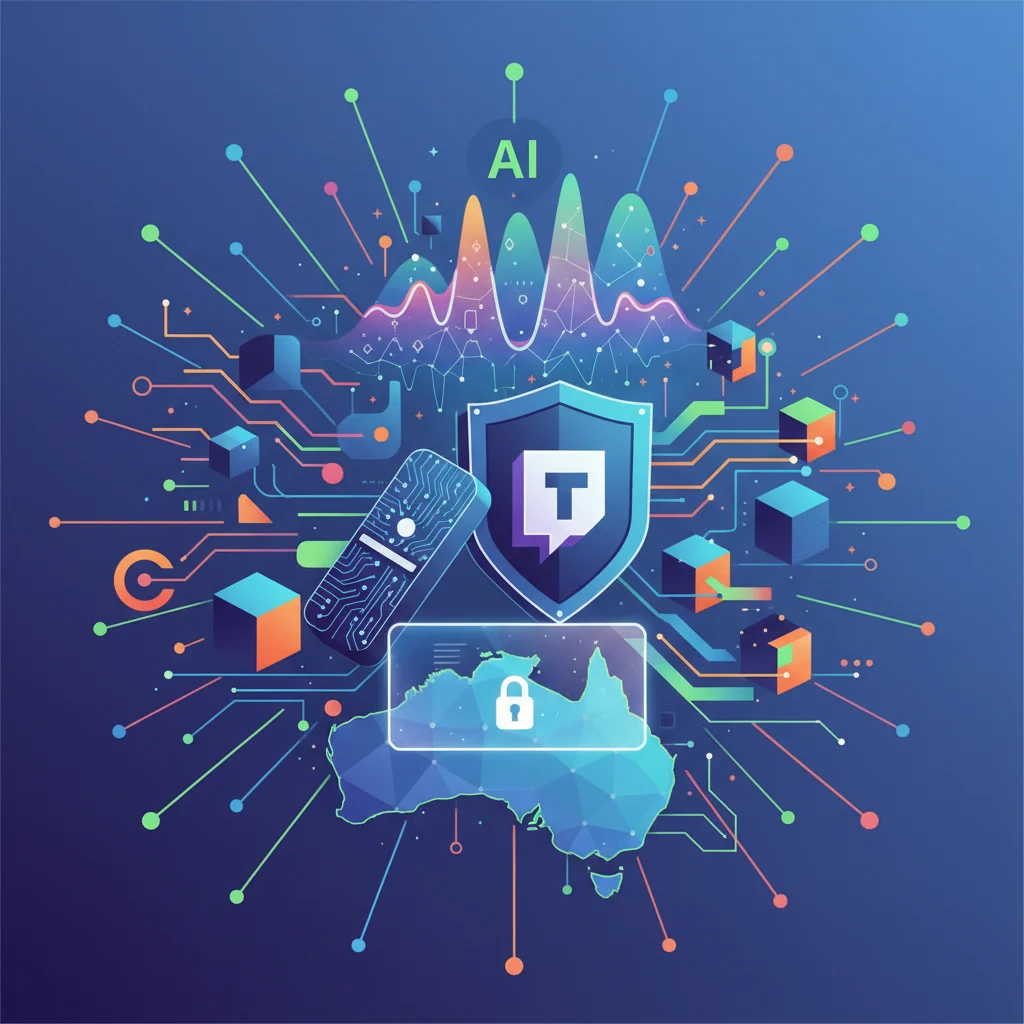
The Code of Conduct: Why Twitch’s Ban in Australia is a Tipping Point for Tech Regulation and AI
Another domino has fallen. The Amazon-owned streaming giant, Twitch, has been added to a growing list of social media platforms facing a ban for users under 14 in South Australia. As reported by the BBC, Twitch now joins the ranks of Meta’s Facebook and Instagram, ByteDance’s TikTok, and Snap’s Snapchat in a landmark trial set to begin next month. On the surface, this might seem like just another regional headline—a localized attempt to curb the well-documented negative effects of social media on teen mental health.
But for those of us in the tech industry—developers, entrepreneurs, and strategists—this is far more than a simple news item. It’s a seismic tremor signaling a fundamental shift in the landscape of digital governance. This isn’t just about user access; it’s about the immense technical, ethical, and financial challenges of compliance. It’s a story about artificial intelligence, complex software architecture, and the future of digital identity. The Australian trial is a real-world stress test for a question that will define the next decade of the internet: How do you prove who someone is online, and who is responsible for doing it?
Unpacking the Mandate: More Than Just a Ban
To understand the gravity of the situation, we need to look beyond the headline. The South Australian government’s initiative is one of the most aggressive legislative pushes we’ve seen globally. The plan not only bans access for children under 14 but also requires parental consent for those aged 14 and 15. The Premier of South Australia, Peter Malinauskas, has been vocal about the government’s intent, citing the “devastating” impact of social media on youth mental health, a sentiment backed by numerous studies. For instance, research has consistently shown correlations between high social media usage and increased rates of anxiety, depression, and poor body image among adolescents (source: American Psychological Association).
The core challenge, however, lies not in the “what” but in the “how.” How can a platform like Twitch, built on a foundation of fast-paced, often anonymous live interaction, effectively enforce such a rule? The legislation places the onus squarely on the tech companies. They are now tasked with building or integrating robust age verification systems. This is where the conversation pivots from policy to programming and from legislation to large-scale technical implementation.
This isn’t a simple “I am over 18” checkbox. The government is expecting sophisticated technological solutions, and failure to comply could result in substantial fines and, ultimately, a complete block within the region. This single piece of regional legislation forces global tech giants to re-evaluate their entire onboarding and user management stack, a multi-million dollar problem that touches every layer of their operations, from front-end UX to back-end cloud infrastructure.
Google's AI Under the Microscope: Why the EU's New Probe Could Reshape the Internet
The Engineering Nightmare: Age Verification at Scale
For a software engineer or a product manager, the phrase “age verification system” triggers a cascade of complex problems. There is no silver bullet. Let’s break down the primary methods and their inherent challenges:
1. Government ID Verification
The most straightforward approach involves asking users to upload a government-issued ID like a driver’s license or passport. This data is then scanned and verified, often using a third-party SaaS provider. While seemingly secure, this method is fraught with issues:
- Cybersecurity Risk: Creating a massive, centralized database of children’s government IDs is a hacker’s dream. A breach would be catastrophic, exposing sensitive data and putting minors at significant risk. The cybersecurity implications are staggering.
- Data Privacy: Users, especially younger ones, are rightly hesitant to share official documents with social media companies. This creates a massive privacy hurdle and could lead to significant user drop-off.
- Exclusion: Not all teenagers have a government-issued photo ID, potentially locking out legitimate users.
2. Facial Age Estimation using AI
This is where cutting-edge artificial intelligence comes into play. Companies are developing sophisticated machine learning models that analyze a user’s selfie to estimate their age. This method is less intrusive than sharing an ID, but it comes with its own set of technical and ethical problems:
- Accuracy and Bias: AI models are only as good as the data they’re trained on. Studies have shown that facial recognition and estimation technologies can exhibit biases based on race, gender, and skin tone, leading to inaccurate results for certain demographics (source: ACLU). An incorrect age gate could wrongfully deny access.
- Liveness Detection: The system must be able to distinguish between a live person and a photo or video of someone else. This requires complex “liveness” checks, adding another layer of software complexity.
- Regulatory Ambiguity: The legal framework around biometric data is still evolving. Storing or processing facial scans, even temporarily, could fall under stringent regulations like GDPR or similar data protection laws.
3. The Rise of RegTech and Automation
The demand for these solutions has fueled a boom in the Regulatory Technology (RegTech) sector. Startups specializing in identity and age verification are racing to provide scalable SaaS solutions. These platforms use a combination of AI, database checks, and sophisticated automation to streamline the verification process for their clients (the social media giants). However, this simply outsources the risk and cost; it doesn’t eliminate it. The social media platform is still ultimately responsible for the data and the outcome.
Below is a comparison of the platforms targeted by the South Australian ban and the unique verification challenges each faces.
| Platform | Primary Content Format | Key Verification Challenge | Potential Role of AI/ML |
|---|---|---|---|
| Twitch | Live Video Streaming & Chat | Anonymity is core to the user experience. Forcing ID verification could fundamentally alter the platform’s culture and alienate its user base. | Real-time facial age estimation of streamers; AI-powered moderation of chat to flag underage users. |
| TikTok | Short-form Video | Massive volume of new user sign-ups daily. Any friction in the onboarding process significantly impacts growth metrics. | AI analysis of video content and user profiles to flag potential underage accounts for manual review or automated verification. |
| Instagram / Facebook | Images, Stories, Reels | Legacy accounts. Verifying millions of existing accounts that never had to provide age proof is a monumental task. | Machine learning models could analyze network connections, post history, and image metadata to predict user age and trigger verification. |
| Snapchat | Ephemeral Messaging & Stories | Privacy-focused design. The platform’s core value proposition is disappearing content, which clashes with the data retention needs of verification. | On-device AI for age estimation that doesn’t require sending facial data to the cloud, preserving privacy. |
My prediction? This will accelerate the development of decentralized or federated digital identity solutions. Instead of every single app and service rolling out their own intrusive age/ID check, we may see the rise of a trusted, user-controlled digital ID (perhaps managed by governments, banks, or tech giants like Apple and Google) that can provide a simple “yes/no” attestation of age to third-party apps without sharing underlying personal data. This creates a massive opportunity for innovation in the cybersecurity and identity management space. The company that cracks the code for a secure, private, and user-friendly digital identity will become the next Stripe or Plaid for the regulated internet. This isn’t just a compliance headache; it’s the next frontier for tech startups.
The Ripple Effect: Beyond Compliance and Code
The implications of this extend far beyond the engineering departments of Big Tech. This regulatory push creates ripples that will be felt across the entire ecosystem.
For Startups and Entrepreneurs
For emerging social platforms, the barrier to entry just got significantly higher. New startups will now have to factor in the cost and complexity of robust age verification from day one. This could stifle innovation, as early-stage companies may lack the resources to implement compliant systems. Conversely, it creates a lucrative market for B2B SaaS companies that can offer “compliance-as-a-service” solutions, turning a regulatory burden into a business opportunity.
For the Future of Programming and Software Development
The next generation of developers will need to be as fluent in data ethics and privacy law as they are in Python or JavaScript. Writing code is no longer just about functionality; it’s about building systems that are secure, ethical, and legally compliant by design. The concept of “Privacy by Design” is moving from a niche academic topic to a core requirement for any consumer-facing software.
The AI Paradox: Is Your Next Job Application Just Shouting into the Void?
The Global Precedent
Make no mistake: the world is watching this Australian experiment. A successful implementation in South Australia could create a blueprint for other regions to follow. A report from the UK’s communications regulator, Ofcom, has highlighted the industry-wide challenges in implementing effective age verification, noting that no single method is foolproof (source: Ofcom). If Australia’s model proves viable, it could trigger a global cascade of similar legislation, fundamentally reshaping the internet’s social layer. Tech companies will be forced to move from a patchwork of regional policies to a more unified, and likely more restrictive, global standard.
Conclusion: The End of the Internet’s Adolescence
The addition of Twitch to South Australia’s social media ban is a seemingly small event with colossal implications. It represents a critical inflection point where societal demands for safety are beginning to outweigh the tech industry’s long-standing ideals of open access and frictionless growth.
The challenge ahead is immense. It requires a delicate balance between protecting vulnerable users and preserving privacy, between fostering innovation and enforcing regulation. The solutions will inevitably be driven by technology—sophisticated AI, secure cloud architectures, and innovative automation. But the guiding principles must come from a place of human-centric design and ethical responsibility.
For every developer writing a line of code, every founder launching a new app, and every professional navigating the tech landscape, the message is clear: the era of the unregulated digital frontier is over. The internet is being asked to grow up, and the process will be complex, costly, and transformative. This isn’t just about a ban in Australia; it’s about the future architecture of trust online.
From Failed Gambit to Market Disruptor: How Valve's Console Dream Redefined Tech Innovation


